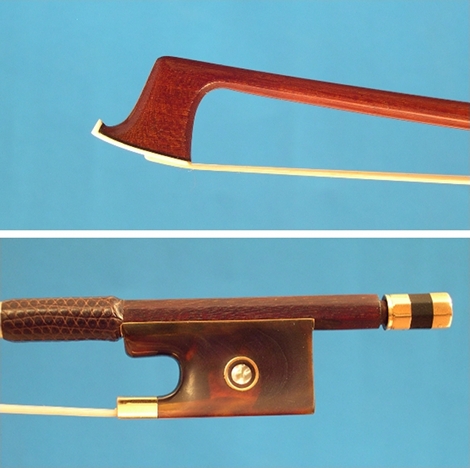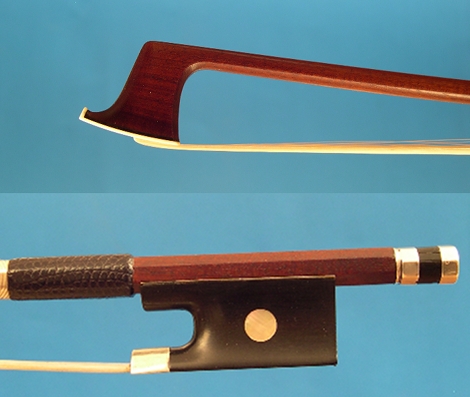PECCATTE, THE SILENT REBELLION
As you already know, in order to establish the authenticity of a bow , the experts base on objective criteria such as the stylistic choices and the sight defects of the craftsman. But the confirmation of this authenticity comes mainly from the character that these forms express and that one of Dominique Peccatte was so strong and dominant, so that although he adopted more than a style, his bows are unmistakable.

Dominique Peccatte's violin bow in gold and tortoise
Tired of the province and his hairdressing job , he arrives in Paris in 1826 at the age of sixteen, and began his apprenticeship at Jean Baptiste Vuillaume's workshop , where he is trained by J.P.M. Persoit. Although both crafsmen are of a very high level , their character is very different. While Persoit is a poet of the bow and build for the joy of it, for Peccatte it is different. For sure he likes to make bows , but for him it is primarily a job so he deals with it as such.
As it is obvious and natural, in the early working years Dominique was inspired by the style of his master, but he cannot get the same results. This is not to say that Persoit's bow are greater than Peccatte's bows , as you know personally I have a fondness for the former, but it is only an elective affinity. The stars of these two craftsmen shine with equal intensity.
Peccatte has never managed to get the same serenity of the shapes simply because he was not a serene guy. Persoit was a joyful and peaceful soul and although fifteen years older than Vuillaume , he always put himself in a corner to work, with no wish of fame, success, or money.
Peccatte was different , he was not a radiant guy not even so tameable and submissive.
He had an exceptional talent and he knew it. His speed of execution compared to the quality of his work is nothing short of impressive, in a few hours he was able to finish a bow starting from the bent stick. Of course, especially when he was working by Vuillaume, a few details that we will see later were unappealing, but in the time that Persoit built a perfect bow, both mechanically and aesthetically, he did ten. They were more rough and concrete, but their mechanics was not less perfect .
Even in his relationship with Vuillaume, he is very different from Persoit. He is certainly one that has had less awe than anyone else towards his boss.
He never felt less than Vuillaume and placed before him as an equal. The established power seemed to be a thing that caused herpes to him. Sometimes he was forced to accept it because he could not do anything else, as in the case of military service. As I said before, he was forced to build an unspecified number of bow to repay it , but if you look at some of them, you can realize how hard he could contain the rage. He must have been furious, each bow carries on it a different dirty word!
The reason he is self convincing himself to accept those things is that always saying yes and obey to the will of his master he had managed to ingratiate him, and that is why in 1836 he was allowed to start working with the elderly Lupot II.
In 1838, after Lupot's death, he takes up the workshop, and from this moment his golden age begins.
The anger that spills over from the Vuillaume's period, becomes supermanhood. The lines are refined and improved , but from them clearly emerges the idea that this man had of himself and his work, as I explained a couple of posts ago, citing a famous character in an Italian movie. He knew he was the number one because he felt like it . As I said, he was shameless, but excellent , actually he can be ranked among the numbers one.
Another weird aspect of Peccatte's character is how he intended work. In 1847, at the top of his career and with an assistant as Pierre Simon, he decided to drop everything and go back home.
He does not care if he is now considered a first level craftsman able to get old training young guys and letting them work for him, he wishes to do something else.
He goes back to Mirecourt and tries to run the small piece of land he inherited by his father and his business go so well that after a few years he buys a new home and devoted himself almost exclusively to the activity of winegrower.
The style
Thanks to his training and uncommon talent Dominique Peccatte has carried out bows with aesthetics that were sometimes very different from each other, but all owned the same force. In the pictures of these two bows the edges of his character stands out clearly.

Dominique Peccatte's violin bow ebony and silver
The design of the throat of the frog is always very aggressive, with the top that rises and recedes, creating a kind of grin, and the effect is accentuated by the greater length of the ring and the whole plate in general.
Even looking at the heads you realize the shape of mind of this manufacturer. The profile of the edge in relation to the inclination of the foot is thrust forward, and the bevel, very wide and covered , intensifies the feeling of bravado. Speaking about bevel, he introduces a small stylistic devices that help to lighten the whole head.As you can see in the one mounted in gold and tortoise, the bevel starts as very wide and then close almost entirely on its arrival on the shoe. This effect is achieved by rotating the bevel slightly down on himself and lowering the cheek of one tenth Come back and look at the two heads to realize how such a small device can deeply change the physicality of a shape.
What else is left to add on a craftsman at this level ? His bows passed , and still pass in the hands of the best musicians of the past two centuries, and each bowmaker of the world envy something of him .
He is the only one equalling his Masters Tourte and Persoit!
So long
Paolo
|